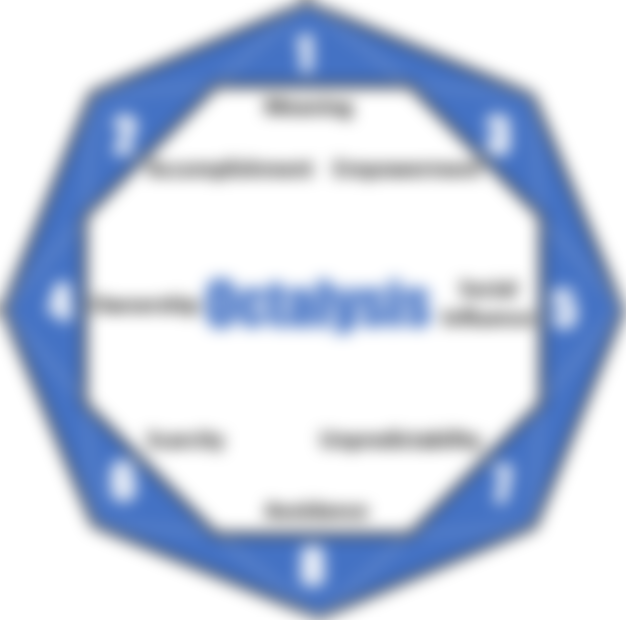Octalysis is a framework for the design and analysis of "human-based" gamification systems. Created by gamification expert Yu-Kai Chou.
If this is the first post you've read on this topic and you don't know what Gamification or the Octalysis Framework is, you can read these two previous posts first:
Octalysis, organization of core drives
Why is gamification necessary
In previous publications we have talked about the importance of gamification in the effective design of systems to achieve a greater and better participation of the human beings who perform it's tasks.
We were talking about how most systems are designed "based on functions" and do not take into account the sensations, feelings, insecurities and reasons why people perform that function. Which can cause the function to not be performed, to be done incorrectly or inefficiently and also to make the person feel bad performing it.
The solution is that the activities associated with our responsibilities are designed in such a way that they are rewarding, fun and positive for the person who performs them. This is achieved by finding the drivers that create the necessary motivation in people.

Human-based design and the Octalysis framework
The Octalysis framework is based on the premise that systems must be designed 'human-based'. The central idea is to design the functions in such a way that people want, feel good, and are motivated to perform those functions. In this way, the person has a special interest in fulfilling the function, and also doing the best that he can.
Octalysis separates and differentiates one type of motivation from another for a better understanding of design. Everything we do is based on one or more of Octalysis's 8 core drives. This is important to keep in mind because it also suggests that if there are none of these core drives behind a desired action, there is no motivation and no behavior occurs.

The previous publication explained what these 8 core drives were and the motivations behind each of them.
Core Drive 1: Meaning and Epic Call
Core Drive 2: Development and Achievement
Core Drive 3: Empowering Creativity and Feedback
Core Drive 4: Ownership and Possession
Core Drive 5: Relationship and social influence
Core Drive 6: Scarcity and Impatience
Core Drive 7: Unpredictability and Curiosity
Core Drive 8: Loss and Avoidance
A process designed with good gamification must take advantage of these core drives to motivate people to perform desired functions. In this way, there are real motivations behind the work to be done and the person who does it feels satisfaction doing it in the best possible way.

In addition, these 8 core drives are distributed in an octagonal structure that forms the Octalysis framework. The position in which each core drives is located within the octagon determines the nature of the influence it exerts on the motivation of people.
Left brain (extrinsic motivation) and Right brain (intrinsic motivation)
The Octalysis framework is organized in such a way that the core drives that focus on creativity, self-expression, and social dynamics are on the right side, named by author Yu-Kai Chou as "Right Brain."

The core drives of the Right Brain depend heavily on intrinsic motivations. These urges are motivating because they make you feel good about yourself.
They let you use your creativity, they allow you to share and compete with others, or they can make you feel suspense and anticipation. The important thing is that motivation depends on internal factors, that is why it is intrinsic and the activity itself is rewarding.

The core drives commonly associated with logic, analytical thinking, and ownership are located on the left side and are called the "Left Brain."
If you can see it, the core drives of the Left Brain are heavily dependent on extrinsic motivations. These impulses motivate because you want to obtain something, be it a goal, or a product, object, recognition or something that you do not already have.
The important thing is that motivation depends on an external factor, that is why it is extrinsic. But these terms are only symbolic representations, it has nothing to do with the hemispheres of the real brain.
This difference is very important because many designers mistakenly believe that including only external motivators such as points, medals and rankings will give them success. It is not like that, many games for example have these elements and are not as successful as others.
The issue is that extrinsic motivators by themselves do not generate the same levels of satisfaction, and much less when the experience is extended over time. To top it off, if those motivators become unattractive, repetitive, or meaningless, then people quickly lose interest.

is much better to design experiences that use both extrinsic and intrinsic motivations in an intelligent and balanced way. Designing a fun and rewarding experience so that users can continuously enjoy and participate in the activity. Motivation is usually best when it is maintained.
White Hat (Positive motivations) and Black Hat (Negative motivations)
Another intended consequence of the core drives positions in the Octalysis framework is the following. The core drives located in the upper part of the octagon are by nature positive, the author calls them “White Hat”.

They provide enriching and uplifting motivations by making the user feel good, either by extrinsic or extrinsic means.

Instead, the lower core drives are negative in nature and are called "Black Hat". They provide motivations that cause fear, stress, anxiety or restlessness. It is important to clarify that the fact that they are negative motivations does not mean that they are bad. These motivators have strong effects that can be used with positive results.
For example, an experience designed to be consistently positive and where there is no sense of danger or expectations are created for the user about something unknown or scarce, is likely to be quickly rejected. It will be fine at first, but eventually it will just be boring.
On the other hand, if an experience is developed with great force in black hat and not so much in white hat, the user will eventually reject it because they will not feel good. A lot of stress or constant fear is nothing positive, perhaps it will catch you for a while, but the time will come for the user to give up.
Based on the Octalysis framework, a good gamification design should consider the 8 core drives and create a balanced experience that allows the user to stay happy, healthy, satisfied and motivated for a long time.
The different levels of complexity of Octalysis
While the Octalysis framework explained so far is great and provides a lot of help in designing great experiences, it's still not all. Designing which characteristics an experience will have based on the 8 core drives and their balance of extrinsic, intrinsic, positive and negative motivations is only Level 1.
That's right, all of this is just the first level of complexity in the Octalysis framework. There are 4 more levels up to 5, of which only the first 3 are public. With each level you can further customize your experiences and they are just great.
If you want to know more about Octalysis and these great concepts you should stay tuned to my posts. In them I will give an example of how this framework would be used in real experiences and we will continue to explain levels 2 and 3.
Gamification design is an art. I wait for you…
There is still much more
The Octalysis framework is a complex and extensive discussion of how to drive people's motivations to perform certain functions. There is no way to explain it in this article alone.
That is why this is part of a series of articles that I invite you to visit to better understand this world of gamification and to realize how great it is and how much it can help the world.
Octalysis, organization of core drives
Invitation
I also invite you to read these other series of articles that detail the operation and amazing results of a cryptocurrency investment system. I invite you not to miss the opportunity to grow your capital without the need for expert knowledge of stock market issues.
TRUST INVESTING, a solid investment
Subscription
If you found this article interesting, you may want to learn more about it and read some more, consider subscribing to my user and you will find out when I publish something new.
Also copying an excellent idea from @CryptoMax, I advise you to visit the profiles of my 3 main sponsors. Their content is excellent and of high quality.
Thank you all…







